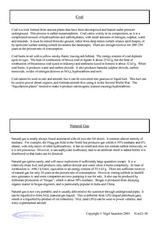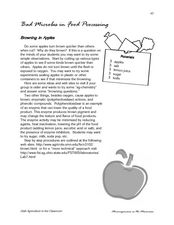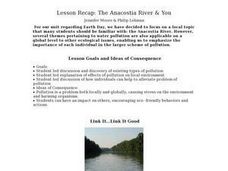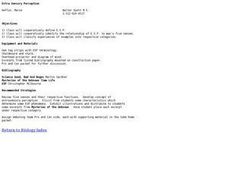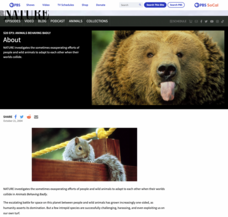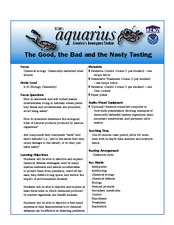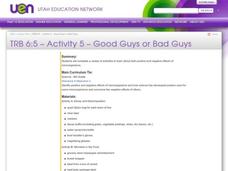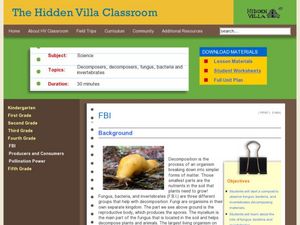National Center for Case Study Teaching in Science
Bad Blood
When it comes to science and medicine, ethics should always be a primary consideration; unfortunately, that has not always been the case. There are countless examples throughout history of questionable medical practices, marginalized...
Curated OER
Correcting Bad Data Using Parity Bits
In this parity bits instructional activity, students read about pixels and data strings. Students are given 2 data strings that are corrupted by cosmic ray glitches and they identify the bad data and create a valid data string.
Creative Chemistry
Fuels - The Good, the Bad, and the Ugly
Science pupils choose from twelve questions about five different types of fuel: hydrogen, ethanol, crude oil, natural gas, and coal. They construct a table to compare them and then determine the best fuel. Your physical science class...
Curated OER
Bad Microbes in Food Processing
Students complete an experiment to determine if there are bad microbes in food processing.In this bad microbe experiment, students use apples to see how they react to oxygen. Students test apples with chemicals to observe the changes.
Curated OER
Bacteria Aren't All Bad!
Teaching students about the diversity of the Bacteria Kingdoms and their importance to humans
Curated OER
Who's Afraid of the Big, Bad Wolf?
Students compare wolves' behaviors to those of the human race. In this wolf lesson plan students write a story that will show that wolves are either good or evil.
Global Oneness Project
The Man and the Wolf
Human attitudes toward the big bad wolf come into focus in a photo essay that asks viewers to consider their own feelings about the endangered species.
Curated OER
Lesson Recap: The Anacostia River & You - Biology Teaching Thesis
Seventh graders give examples of local sources of pollution and postulate reasons as to why local sources of pollution can harm the ecosystem. They address the following question in short answer form: "Why is litter/chemical pollution...
Teach Engineering
Restriction Enzymes and DNA Fingerprinting
Show your class why restrictions aren't always a bad thing. In the third segment of a four-part series, the instructor develops the idea of restriction enzymes. Pupils learn how scientists use restriction enzymes in DNA analysis and DNA...
Biology Junction
Cnidarians and Ctenophorans
Cnidaria is a broad phylum of 11,000 different species from jellyfish to coral. Most Cnidarians are marine species with a few freshwater examples. A lesson presentation explains the important characteristics of different species of...
Curated OER
Theater Game: "The Good, the Bad, and the Bountiful"
Students play a game to demonstrate the detrimental effects of an algal bloom on the environment. In this microorganism lesson, students discuss microbes and algae. They dramatize the effects of an algal bloom using a role-playing game.
Curated OER
"The Good, The Bad, and The Smelly."
Students explore insects' use of pheromones and beneficial insects versus insect pests.
Curated OER
Extra Sensory Perception
Students define extra sensory perception. In this science lesson plan, students identify the relationship of E.S.P. to man's five senses and classify experiences of examples into respective categories.
Curated OER
Animals and People: Who's Behaving Badly?
Young scholars explore the relationship between human beings and animals. They participate in a variety of activities to examine animal behavior. Students create a class book and stage a mock news broadcast.
Curated OER
The Good, the Bad and the Nasty Tasting
Students examine the effect of chemicals from marine plants or animals on predator's preferences. In this ecology lesson, students conduct taste tests and collect necessary data. They write their conclusion after analyzing...
Curated OER
Good Guys or Bad Guys
Sixth graders complete a variety of activities to explore both positive and negative effects of microorganisms. They, in groups, engage in a series of experiments which illustrate the effects of certain molds.
Curated OER
What a Weed-- Wanted Posters
In this science worksheet, students draw sketches of "weedy criminals" and write about their bad points and how we can get them under control. Students then draw "wonderful weeds" and tell how someone would grow them.
Curated OER
Chemical and Physical Changes Homework
In this chemical and physical change worksheet, students determine if 5 statements are examples of chemical or physical changes. At home they find 1 example of a chemical change and 1 example of a physical change. They explain why each...
Curated OER
Two Way Causality in Ecosystems
Students complete various activities in order to explain that ecosystems are complex and that animal behavior (mainly that of a predator) is not necessarily intentional or bad.
Curated OER
Make Words with the Letters in the Word Badger
In this language arts and science worksheet, students make as many words as they can using the letters in the word "badger." They are encouraged to make at least 17 words. They see examples at the bottom of the page.
Curated OER
Yeast Power!
Students examine how not all microorganisms are bad and that some can actually be beneficial. In this yeast lesson students complete an experiment with yeast and answer questions.
Curated OER
Cloning
Students view the history to cloning cats. Students show examples of what they know about cloning. Students surf the net on all theories on cloning. Students view the critics views on cloning.
Biology Junction
Macromolecules
In chemistry, organic means something contains a carbon base. A helpful presentation starts by defining macromolecules as large organic carbon molecules. Scholars answer questions about each topic on the associated worksheet. It covers...
Curated OER
FBI
Fourth graders experiment with compost. In this Science instructional activity, 4th graders begin a worm compost as well as an outdoor compost. Students discuss decomposition.
Other popular searches
- Bad Grammar Examples
- Examples of Bad Citizenship
- Examples of Bad Characters
- Examples of Bad Lesson Plans


